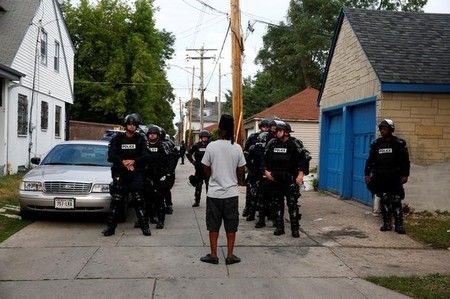Advertisement
Riot-torn Milwaukee has quieter night before Trump’s visit

By Brendan O’Brien
MILWAUKEE (Reuters) – Milwaukee’s curfew on teenagers and community leaders’ calls for restraint calmed the city somewhat overnight after two nights of riots sparked by the fatal police shooting of a black man.
The city was due to become a focus of the U.S. presidential race later on Tuesday. Republican nominee Donald Trump will visit and participate in a previously scheduled televised town hall meeting with Fox News host Sean Hannity, raising the possibility of protests similar to those that have followed the candidate elsewhere during the campaign.
Police said Sylville Smith, 23, was killed on Saturday afternoon after he fled a black officer who had stopped him for acting suspiciously. They said Smith was carrying an illegal handgun and refused orders to drop it when he was shot.
Peaceful demonstrations in the Sherman Park area where Smith died turned into violent protests on Saturday and Sunday nights. Shots were fired, and some rioters torched businesses and police cars. Angry crowds pelted riot police with bottles and bricks.
Eight officers were wounded, and dozens of people were arrested, police said. One person suffered a gunshot wound.
Monday night was much quieter after a citywide curfew for minors took effect at 10 p.m. Police said there were 10 arrests, one report of shots fired and no property damage.
“We think we are in, comparatively speaking, a positive place,” Milwaukee Police Chief Ed Flynn told reporters as it became apparent the curfew was being respected. “We had folks from the community step forward to take a leadership role in reducing tensions.”
Milwaukee has become the latest U.S. city to be gripped by unrest after high-profile police killings of black men over the past two years. Many of the officers involved in the earlier shootings were white, however, and the victims were unarmed.
Famous for its breweries, Milwaukee is one of the most racially divided U.S. cities, with a black population plagued with higher levels unemployment that are absent in the mostly white suburbs.
Mayor Tom Barrett said on Monday that nightly curfews on teenagers would remain in place “for as long as necessary.”
Barrett has urged state officials to release video of Smith’s shooting as soon as possible in hopes that it would corroborate the police department’s account and convince protesters the use of deadly force was justified.
Wisconsin state law requires police shootings be investigated by an independent state agency, which controls such evidence.
(Reporting by Brendan O’Brien in Milwaukee; Writing by Curtis Skinner; Editing by Lisa Von Ahn)
















